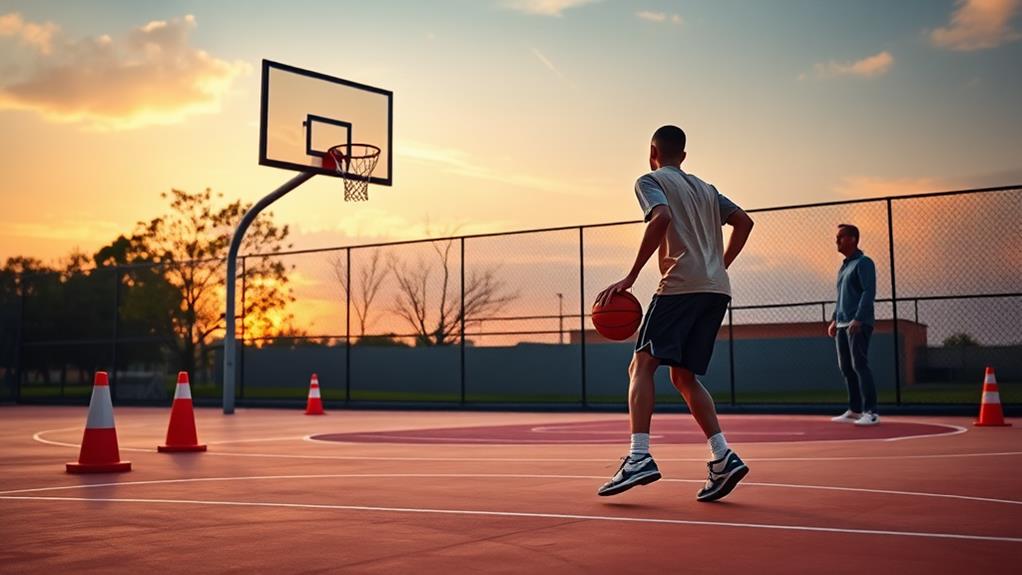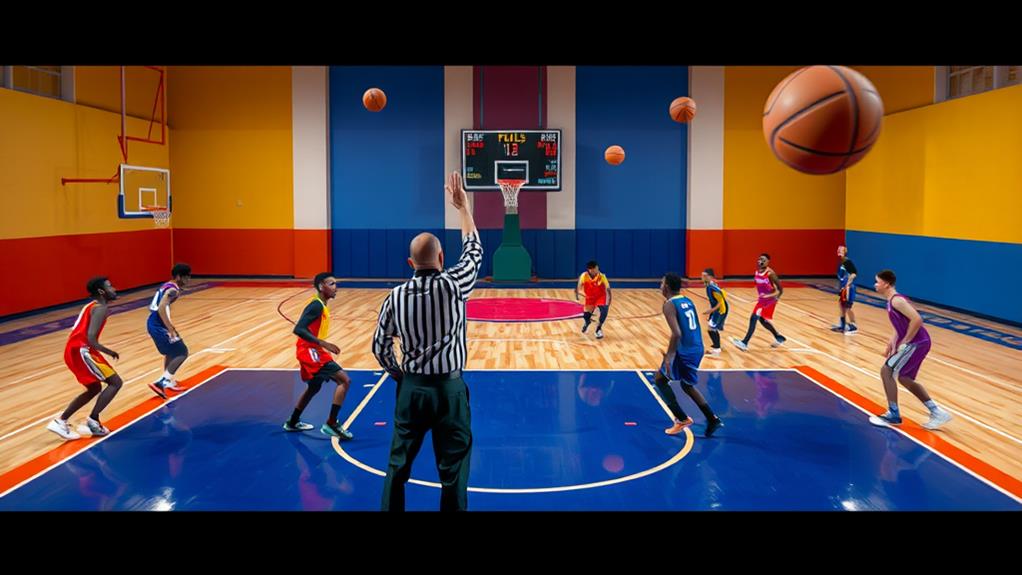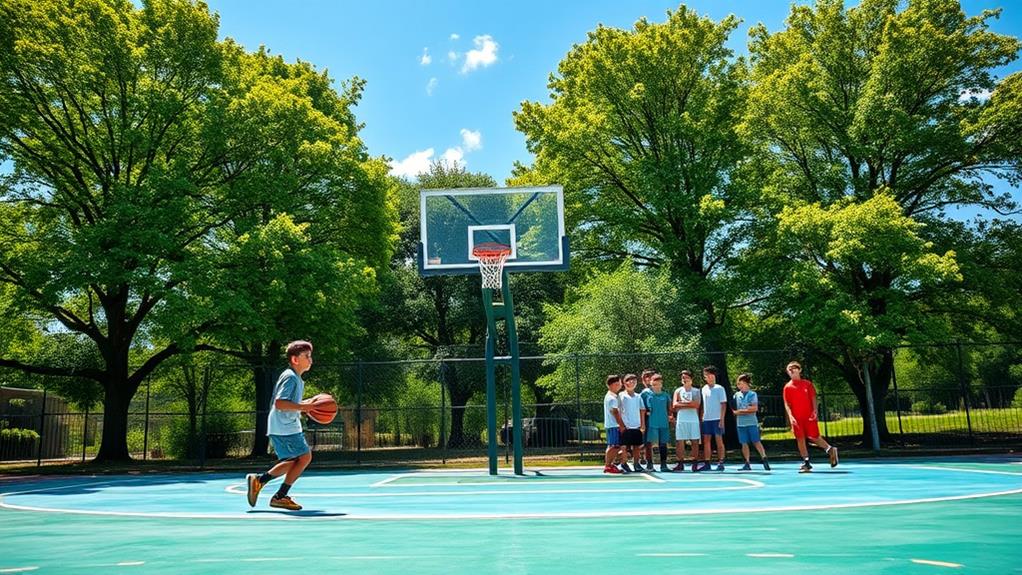
The Basics of Simple Basketball: For Beginners and Beyond
November 17, 2024To get started with basketball, you'll want to understand the basics: two teams of five aim to score by shooting a ball through a 10-foot hoop. Focus on key skills like dribbling, passing, and shooting, as these are essential for gameplay. Familiarize yourself with the game rules, including common violations like traveling and fouls. Each position has unique roles that contribute to team success, from the center's rebounding to the guard's playmaking. Playing offers fitness benefits and enhances coordination. If you want to master the game, there's so much more to explore about strategies and skills.
Understanding the Game
When you step onto the basketball court, it's essential to grasp the basics of the game. Understanding how the game is played lays the foundation for your basketball knowledge. You'll notice that two teams of five players each work together to create scoring opportunities. The objective is simple: shoot the ball through a 10-foot hoop to score points.
The evolution of equipment has greatly influenced how players perform, making the game more exciting and dynamic.
The game starts with a tip-off at center court, where the referee tosses the ball between players to determine initial possession. Scoring is categorized into three types: 2 points for baskets made inside the three-point arc, 3 points for shots made beyond it, and 1 point for free throws after fouls. Each game is structured into halves or quarters, depending on the level of play.
As an offensive player, you'll often have the ball and need to make quick decisions. When a player dribbles the ball, they must be aware of the basic rules of basketball, like not holding it for more than ten seconds while crossing the mid-court line.
With these fundamentals, you'll be well on your way to enjoying and excelling in basketball.
Key Skills for Players
Basketball is all about mastering key skills that can elevate your game and enhance your team's performance.
To start, dribbling is a fundamental skill that lets you advance the ball and create offensive plays. Understanding basic rules such as field dimensions and equipment requirements can help you maintain control and improve your efficiency. Practice bouncing the ball while moving to improve your control and speed.
Next, shooting techniques, including layups, jump shots, and three-pointers, are crucial for scoring. Remember, three-pointers are worth three points, while regular baskets score two.
Passing is equally critical; it facilitates ball movement and helps you find open teammates for scoring opportunities. Effective teamwork hinges on good communication, so always be aware of your teammates' strengths and weaknesses.
Defensive skills shouldn't be overlooked, either. Guarding opponents, blocking shots, and stealing the ball are essential for preventing the other team from scoring. Each player must understand their role on defense to maintain a strong team dynamic.
Game Rules and Violations

In basketball, understanding the game rules is essential for playing effectively. You'll need to be aware of common violations, like traveling and double dribbling, that can cost your team possession.
Additionally, similar to the significance of yellow cards in soccer, being mindful of fouls can help players maintain discipline and avoid unnecessary penalties that disrupt gameplay.
Plus, knowing the different types of fouls can help you avoid unnecessary penalties and keep the game flowing smoothly.
Key Game Rules
Understanding key game rules is essential for enjoying and playing basketball effectively. One important aspect is the shot clock, which gives you just 24 seconds to attempt a shot. If you don't shoot in time, your team loses possession of the ball. As a player, you need to keep an eye on this clock while executing your plays.
Fouls play a notable role in the game. Personal fouls occur from illegal physical contact, and when you're fouled, you may be awarded free throws. Accumulating too many fouls can lead to bonus situations, granting your team additional free throws after a set number of fouls in a quarter.
It's also essential to avoid common violations like traveling, double dribbling, or staying in the key for over three seconds. These infractions can disrupt your team's flow and give the ball to the opponent.
Balancing aggressive play with adherence to these key rules is essential. Remember, a well-timed play can lead to scoring opportunities, while careless fouls can greatly impact the game's outcome, especially in critical moments.
Stay sharp, and you'll enjoy the game even more!
Common Violations Explained
Playing basketball means maneuvering a set of specific rules, and common violations can trip you up if you're not careful. One of the most frequent violations is traveling, which happens when you take too many steps without dribbling, resulting in a turnover. Be cautious about double dribbling, too; if you dribble, stop, and then start again, that's a violation that leads to a loss of possession.
Another common issue is the three seconds in the key rule. If you're an offensive player lingering in the key for more than three seconds while your team has the ball, that'll cost you.
Goaltending is a critical violation as well; if you interfere with a shot that's on its way down or after it's had a chance to enter the basket, the offense scores the points.
Lastly, keep an eye on personal fouls. Illegal physical contact can pile up quickly, and too many can get you disqualified or grant your opponent free throw opportunities.
Understanding these violations helps you play smarter and more effectively on the court.
Foul Types Overview
Fouls in basketball can greatly influence the game's flow and outcome. Understanding the different types of fouls is essential for any player.
Personal fouls occur when you make illegal physical contact with an opponent, like hitting, pushing, or holding. These fouls can lead to free throw opportunities for the fouled player.
Shooting fouls are a specific category of personal fouls that happen during a shot attempt. If you commit a shooting foul, the fouled player is awarded two or three free throws, depending on where the shot was taken.
Non-shooting fouls, on the other hand, don't result in free throws; instead, the fouled team gains possession of the ball, which can change your game strategy.
Technical fouls are issued for unsportsmanlike conduct or procedural errors, such as arguing with referees. They also result in free throws awarded to the opposing team.
Keep in mind that common game violations like traveling, double dribble, and goaltending can lead to a loss of possession and disrupt offensive plays.
Understanding these fouls helps you play smarter and more strategically.
Player Positions and Roles
In basketball, there are five key player positions—two guards, two forwards, and a center—each with unique roles that contribute to the team's success.
Centers are typically the tallest players on the court, focusing on scoring close to the basket, securing rebounds, and blocking opponents' shots. You'll find that a center's strength and height are essential for dominating the paint. This emphasis on height and skill can also be seen in sports with similar team dynamics, such as the evolution of soccer, where players' physical attributes play a considerable role in their positions.
Forwards, generally versatile, operate both near the basket and on the perimeter. They excel in scoring by taking outside shots and driving for layups while also contributing greatly to rebounding efforts. Their ability to adapt makes them critical players in any offense.
Guards are usually the shortest and quickest players, skilled in dribbling and passing. Their primary roles include orchestrating the offense, creating plays, and disrupting the opponent's strategies on defense. Guards need to be agile and possess excellent ball-handling skills.
Understanding these player positions and their roles is essential as you engage in basketball. Each position requires specific skill sets: centers excel in rebounding and shot-blocking, forwards balance inside and outside scoring, and guards focus on playmaking and defense.
Fitness and Health Benefits

Playing basketball isn't just about scoring points; it's a fantastic way to boost your cardiovascular health and improve your endurance. Engaging in this sport helps develop agility and strength, which are essential for overall fitness.
As you dribble and shoot, you'll enhance your coordination and balance, making every move feel more natural. Plus, the social interaction you get on the court can strengthen bonds and help you feel more connected to others.
For more related insights, check out home workouts that can enhance your game.
Cardiovascular Health Improvement
Basketball isn't just a fun way to spend time with friends; it also considerably boosts your cardiovascular health. When you play, your heart rate increases, enhancing your cardiovascular fitness and promoting better blood circulation.
The high-intensity intervals—like sprinting and quick directional changes—improve both your aerobic and anaerobic endurance, making you a more well-rounded athlete.
Regularly engaging in basketball can considerably lower your risk of cardiovascular diseases, as it helps reduce blood pressure and improve cholesterol levels. You'll also burn between 300 to 800 calories per hour, depending on how intensely you play and your body weight, which aids in weight management.
The dynamic movements involved in the game, such as running, jumping, and lateral agility, contribute to better heart and lung function. Over time, these benefits lead to improved overall cardiovascular health, allowing you to enjoy the game even more.
Enhanced Coordination and Balance
How can a simple game enhance your coordination and balance? Basketball's dynamic movements require players to constantly adjust their body positioning to dribble, pass, and shoot effectively. This constant adjustment helps improve your coordination, making it easier to perform complex movements both on and off the court.
As you navigate the court, you'll need to maintain balance during rapid direction changes or while jumping to take a shot or grab a rebound. This practice enhances your overall stability and body awareness, crucial for executing the fundamentals of the game.
Engaging in basketball also strengthens your core muscles, which are essential for maintaining proper posture and balance during gameplay. With regular participation, you'll notice improvements in your agility. You'll develop the ability to change direction quickly and efficiently while keeping control of the ball.
Moreover, studies show that playing basketball boosts cardiovascular fitness, which supports better coordination and balance through increased stamina and endurance.
Social Interaction Opportunities
Engaging in basketball not only sharpens your coordination and balance but also opens the door to valuable social interaction opportunities.
When you join a team, you immerse yourself in a collaborative environment that fosters communication and teamwork. This team dynamic often leads to the development of lasting friendships, enriching your social life.
Participating in local leagues or community events enhances your connection with diverse groups of people, allowing you to form a strong sense of belonging.
As you practice, compete, and celebrate victories together, you share experiences that can deepen these bonds.
Basketball isn't just about scoring points; it's also a platform for developing essential life skills like leadership, discipline, and cooperation.
These skills translate beyond the court, improving your interactions in various social settings.
The friendships and connections you build through basketball create a robust support system within your community.
Coaching Fundamentals
To help players improve their skills, grasping the fundamentals of basketball is essential for any coach. By focusing on core skills like shooting accurately, passing, dribbling, and defense, you can greatly enhance your team's performance.
Additionally, understanding how to optimize player roles through data analysis can provide insights that elevate skill development.
Here are some key coaching fundamentals to reflect on:
- Understand the Fundamentals: Make sure you have a solid grasp of the game's basics; this sets the foundation for your players' skill development.
- Structured Drills: Organize practice sessions that include diverse drills. This keeps players engaged and promotes continuous improvement in their skill in basketball.
- Emphasize Teamwork: Teach your players the importance of working together. Teamwork not only improves game performance but also fosters camaraderie.
- Utilize Coaching Resources: Leverage available materials, such as youth programs or expert guidance from figures like Bob Bigelow, to enhance your coaching strategies.
Getting Started in Basketball

Starting your basketball journey can be exciting and a bit overwhelming, but grasping the basics will set you on the right path. First, familiarize yourself with the court. Basketball is played on a rectangular court with a 10-foot high hoop. Games typically start with a tip-off at center court, and understanding the structure—like two 20-minute halves in college or four 8-minute quarters in high school—will help you adjust.
As you immerse yourself, take inspiration from the pioneering figures in women's basketball, such as pioneering legend Nera White, who set remarkable standards and showcased exceptional skills in the sport.
Focus on essential skills like dribbling, passing, and shooting. Dribbling helps you move with the ball, while passing is vital for teamwork and setting up plays. Shooting is your ticket to scoring points, so practice your technique regularly.
Joining local basketball programs, such as classes or clinics, is an excellent way to develop these skills and build confidence. You'll not only improve your gameplay but also learn how to work with teammates, as basketball is a team sport that thrives on collaboration.
Conclusion
In the vibrant tapestry of basketball, you've woven together the threads of skill, strategy, and teamwork. As you step onto the court, remember that every dribble and shot echoes the passion you bring to the game. Embrace the challenges and celebrate your growth, for each practice is a stepping stone towards mastery. So lace up those sneakers, feel the rhythm of the game, and let your love for basketball shine like a beacon to those around you.


